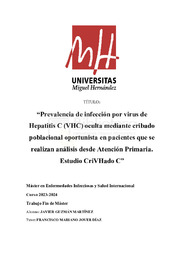Resumen :
Para la consecución de los objetivos para 2.030 de la Organización Mundial de la Salud han cobrado relevancia las estrategias de cribado universal del virus de la hepatitis C (VHC). En España, con una prevalencia de infección activa del 0,22% (significativamente más elevada en nacidos entre 1.948-1.967), no se recomienda el cribado poblacional actualmente.
Nuestro objetivo es medir la prevalencia en nuestro departamento de la infección por VHC no conocida, y sus variables asociadas, mediante la aplicación de una estrategia de cribado poblacional oportunista en adultos con edades entre 40-80 años atendidos en Atención Primaria y se realicen una analítica por cualquier motivo.
El cribado se implementó durante 6 meses (febrero-julio de 2.024), realizándose a 7.013 pacientes de los 11.490 ofrecidos (61,03%). Se documentaron 55 casos con resultado positivo en la serología (0,78%), y 9 casos con RNA-VHC positivo (0,13%). Se observó una mayor frecuencia de exposiciones de riesgo, comorbilidades psiquiátricas, y valores anormales de enzimas hepáticas en pacientes con RNA-VHC positivo respecto a los negativos, sin encontrarse diferencias estadísticamente significativas.
En conclusión, con la aplicación de nuestra estrategia de cribado hemos conseguido detectar 0,13% de infecciones activas, siendo atendidas precozmente por el especialista.
achieve the World Health Organization's 2030 targets. In Spain, with a prevalence of active infection of 0.22% (significantly higher in those born between 1948-1967), population screening is not currently recommended.
Our objective is to measure the prevalence of unknown HCV infection and its associated variables in our department by applying an opportunistic population screening strategy inadults aged between 40-80 years who are treated in Primary Care and undergo an analysisfor any reason.
The screening was implemented for 6 months (February-July 2024), performing 7,013 patients out of the 11,490 offered (61.03%). 55 cases were documented with a positive result in serology (0.78%), and 9 cases with positive HCV-RNA (0.13%). A higher frequency of risk exposures, psychiatric comorbidities, and abnormal values of liver enzymes were observed in patients with positive HCV-RNA compared to those who werenegative, with no statistically significant differences.
In conclusion, with the application of our screening strategy we have managed to detect 0.13% of active infections, being treated early by the specialist.
|
 La licencia se describe como: Atribución-NonComercial-NoDerivada 4.0 Internacional.
La licencia se describe como: Atribución-NonComercial-NoDerivada 4.0 Internacional.
.png)
